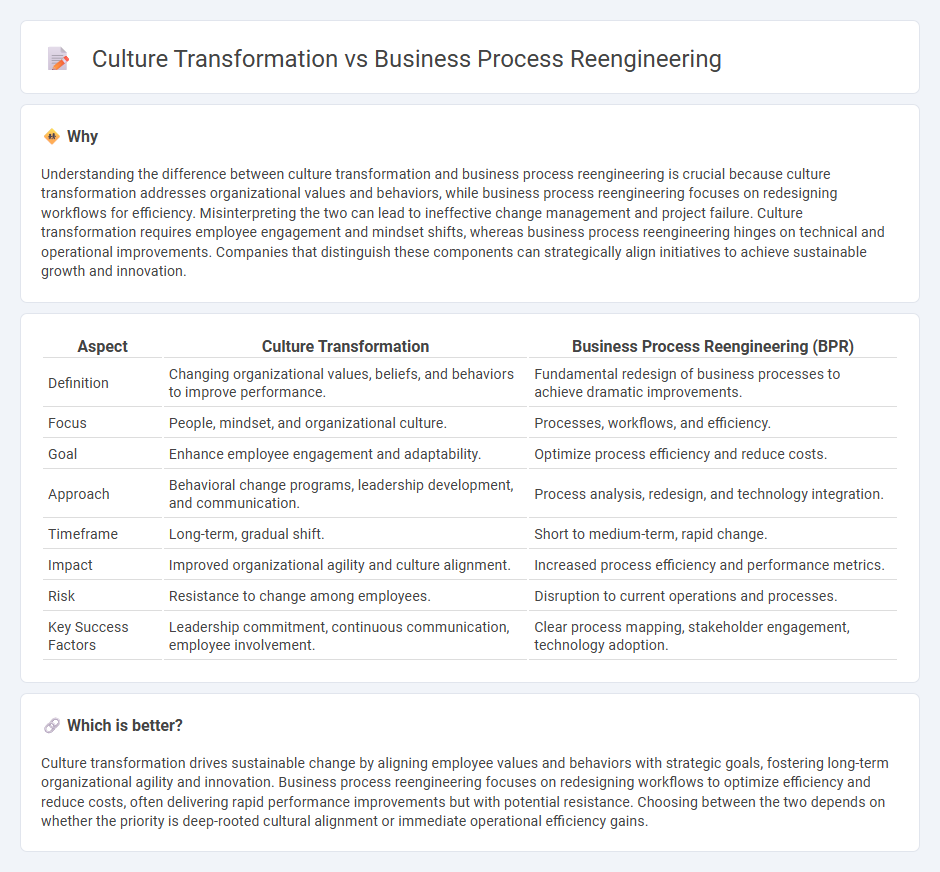
Culture transformation focuses on reshaping organizational values, behaviors, and mindsets to drive sustainable change and employee engagement. Business process reengineering involves analyzing and redesigning workflows to improve efficiency, reduce costs, and enhance customer satisfaction. Discover how strategic consulting balances these approaches to maximize organizational performance.
Why it is important
Understanding the difference between culture transformation and business process reengineering is crucial because culture transformation addresses organizational values and behaviors, while business process reengineering focuses on redesigning workflows for efficiency. Misinterpreting the two can lead to ineffective change management and project failure. Culture transformation requires employee engagement and mindset shifts, whereas business process reengineering hinges on technical and operational improvements. Companies that distinguish these components can strategically align initiatives to achieve sustainable growth and innovation.
Comparison Table
| Aspect | Culture Transformation | Business Process Reengineering (BPR) |
|---|---|---|
| Definition | Changing organizational values, beliefs, and behaviors to improve performance. | Fundamental redesign of business processes to achieve dramatic improvements. |
| Focus | People, mindset, and organizational culture. | Processes, workflows, and efficiency. |
| Goal | Enhance employee engagement and adaptability. | Optimize process efficiency and reduce costs. |
| Approach | Behavioral change programs, leadership development, and communication. | Process analysis, redesign, and technology integration. |
| Timeframe | Long-term, gradual shift. | Short to medium-term, rapid change. |
| Impact | Improved organizational agility and culture alignment. | Increased process efficiency and performance metrics. |
| Risk | Resistance to change among employees. | Disruption to current operations and processes. |
| Key Success Factors | Leadership commitment, continuous communication, employee involvement. | Clear process mapping, stakeholder engagement, technology adoption. |
Which is better?
Culture transformation drives sustainable change by aligning employee values and behaviors with strategic goals, fostering long-term organizational agility and innovation. Business process reengineering focuses on redesigning workflows to optimize efficiency and reduce costs, often delivering rapid performance improvements but with potential resistance. Choosing between the two depends on whether the priority is deep-rooted cultural alignment or immediate operational efficiency gains.
Connection
Culture transformation and business process reengineering are interconnected as both aim to enhance organizational efficiency and adaptability by reshaping employee mindset and operational workflows. Successful business process reengineering requires a culture that embraces change, innovation, and continuous improvement to overcome resistance and implement new processes effectively. Aligning cultural transformation initiatives with reengineering efforts ensures sustainable performance improvements and drives long-term business success.
Key Terms
**Business Process Reengineering:**
Business Process Reengineering (BPR) involves fundamentally redesigning core business processes to achieve dramatic improvements in productivity, efficiency, and quality, often leveraging technology and data analytics for optimization. Unlike culture transformation, which focuses on shifting organizational values and employee behaviors, BPR targets the structural workflow and operational frameworks to eliminate redundancies and streamline activities. Explore more about how BPR can revolutionize your organization's performance and innovation capacity.
Process Mapping
Business process reengineering involves fundamentally redesigning core business processes to achieve significant improvements in productivity, efficiency, and quality, with process mapping serving as a crucial tool to visualize and analyze existing workflows. Culture transformation emphasizes shifting organizational values, behaviors, and mindsets to support new ways of working, using process mapping to identify and align cultural touchpoints with operational changes. Explore how integrating process mapping in these approaches can drive comprehensive organizational success.
Workflow Optimization
Business process reengineering (BPR) focuses on radically redesigning workflows to achieve significant improvements in efficiency, cost reduction, and service delivery by analyzing and restructuring core business processes. Culture transformation, while impacting workflows, primarily targets behavioral change, mindset shifts, and organizational values to foster continuous improvement and employee engagement. Explore how aligning BPR with culture transformation drives sustainable workflow optimization and organizational success.
Source and External Links
A Complete Guide to Business Process Reengineering - This guide provides a structured approach to implementing BPR, involving steps from identifying inefficiencies to monitoring and refining new processes.
Business Process Reengineering - BPR involves a radical redesign of business processes to improve productivity, cycle times, quality, and satisfaction by refocusing on customer needs and eliminating low-value work.
Business Process Reengineering: Benefits, Examples & Steps - This article outlines the five key steps of BPR, including mapping current processes, identifying gaps, and designing future-state processes to significantly improve organizational efficiency.
 dowidth.com
dowidth.com